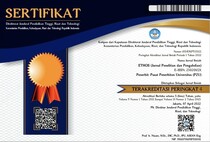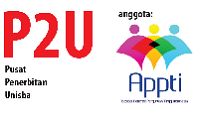Preferensi Konsumen Generasi Z terhadap Konsumsi Produk Dalam Negeri
Abstract
Abstract. This research analyzed the influenced factors that affect to the Generation Z preferance for various daily products and services and used a descriptive method. The respondents was 328 students. The samples determined purposively with the criteria they were students, which are category Z generation under 20 years old. The result showed that consumer preference for food and beverage, clothing and gadgets and higher education choices were the highest percentage of prices, while the largest percentage communication services in brand providers, for transportation products were convenience, and tourism preferences were in the natural beauty. 63.72 percent consumer prefered conventional transaction platforms compared to online transaction platform. Consumers (80.28 percent) preferred to domestic product rather than foreign products. Logistic regression analysis reveraled that the higher income of respondents will increase 2,843 times the chance of respondents to use domestic products with a natural log value of 1,045. Respondents who chose the conventional market platform, the opportunity to use domestic production will increase 2,781 times compared to the use of foreign products. While the more the quality of food and beverage products, the opportunities of domestic product consumtion tendency increased by 0,510 times compared to foreign product.
Abstrak. Penelitian ini menganalisis preferensi yang mempengaruhi tingkat kepuasan Generasi Z terhadap berbagai produk/jasa dan penelitian ini menggunakan metode deskriptif. Penentuan responden ditentukan secara purposive dengan kriteria responden adalah mahasiswa reguler IBI Kosgoro aktif, kategori generasi Z yang berusia < 20 tahun yang berjumlah 328 responden. Hasil penelitian menunjukkan bahwa preferensi konsumen terhadap produk makanan dan minuman, pakaian dan gadget dan pilihan pendidikan tinggi persentase terbesar pada harga, Sementara jasa komunikasi persentase terbesar pada brand provider, untuk produk transportasi pada kenyamanan, dan preferensi terhadap wisata adalah pada keindahan alam yang ditawarkan wisata tersebut. Konsumen sebesar 63,72 persen lebih memilih platform transaksi secara konvensional dibandingkan online. Konsumen 80,28 persen memiliki preferensi untuk membeli produk dalam negeri dibandingkan produk luar negeri. Analisis regresi logistik menunjukkan bahwa semakin tinggi pendapatan responden maka akan meningkatkan 2,843 kali peluang responden untuk menggunakan produk dalam negeri dengan nilai log natural 1,045. Responden yang memilih platform pasar konvensional maka peluang penggunaan produksi dalam negeri akan meningkat 2,781 kali dibandingkan penggunaan produk luar negeri. Sedangkan semakin berkualitas produk makanan dan minuman, responden akan cenderung mengkonsumsi produk dalam negeri dengan peluang yang akan meningkat sebesar 0,510 kali dibandingkan konsumsi produk makanan dan minuman dari luar negeri.
Keywords
Full Text:
PDFReferences
Abdul, A. (2014). Young consumers’ attitude towards halal food outlets and JAKIM ’ s halal certification in Malaysia. Procedia - Social and Behavioral Sciences, 121(September 2012), Pp: 26–34.
https://doi.org/10.1016/j.sbspro. 2014.01.1105
Abdul, Z., Ho, B., & Mahdi, R. (2016). Exploring the Dimensions of Contract Manufacturing Service Quality for the F & B Industry. Procedia - Social and Behavioral Sciences, 224(August 2015), Pp:76–83. https://doi.org/ 10.1016/j.sbspro.2016.05.403
Adwinchia, Inggritha. (2015). Tren Pembelian Online pada Generasi Milenial Indonesia (Studi pada E-commerce Zalora Indonesia). Universitas Indonesia. Depok.
Adwere-boamah, J., & Hufstedler, S. (2015). Predicting social trust with binary logistic regression, 27, Pp: 1–6.
Alibabi, V., Joki, S., Muji, I., Rudi, D., & Bajramovi, M. (2011). Attitudes , behaviors , and perception of consumers ’ from northwestern Bosnia and Herzegovina toward food products on the market, 15, Pp:2932–2937. https://doi.org/10.1016/j.sbspro.2011.04.217.
Alphonce, R., & Temu, A. (2015). European consumer preference for African dried fruits. https://doi.org/10.1108/BFJ-10-2014-0342
Batra, R., Alden, D. L., & Steenkamp, J. (2000). Effects of Brand Local and Nonlocal Origin on Consumer Attitudes in Developing Countries Effects of Brand Local and Nonlocal Origin on Consumer Attitudes in Developing Countries. Journal of Consumer Psychology. 9(2). Pp:83-95. Pp:https://doi.org/10.1207/ S15327663JCP0902
Carpenter, J. M. (2012). Acculturation to the global consumer culture: A generational cohort comparison. Journal of Strategic Marketing 20(5), Pp:411-423.
Charles, K. K., Hurst, E., & Roussanov, N. (2009). Conspicuous consumption and race. Quarterly Journal of Economics, 124(2), Pp: 425–467.
Chung, K. C. (2014). Gender, culture and determinants of behavioural intents to adopt mobile commerce among the y Generation in transition economies: Evidence from Kazakhstan. Behaviour and Information Technology, 33(7), Pp: 743–756. https://doi.org/10.1080/0144929X.2013.805243
Edu, T., & Preda, O. (2014). Journal of IndustriaTextilă, 65(6), Pp:349–358.
Elliot, M. & Mark Tranmer. (2015). Binary Logistic Regression. Cathie Marsh Centre Census and Survey Research. London. https://www.cmist.manchester.ac.uk/
Erceg, N., & Bubic, A. (2018). The Role of Decision Making Styles in Explaining, Pp:213–229. https://doi.org/10.1007/s10902-016-9816-z
Eren, S. S. (2013). Young Consumers’ Attitudes toward American products. Procedia - Social and Behavioral Sciences, 99, Pp:489–495. https://doi.org/10.1016/j.sbspro.2013.10.517
Pilone, V., Stasi, A., & Baselice, A. (2017). Quality preferences and pricing of fresh-cut salads in Italy : new evidence from market data, 119(7), Pp: 1473–1486. https://doi.org/10.1108/BFJ-09-2016-0419
Hands, D. W. (2013). Foundations of Contemporary Revealed Preference Theory, Pp: 1081–1108. https://doi.org/10.1007/s10670-012-9395-2
Hazlin, N., Asshidina, N., Abidin, N., & Bashira, H. (2016). Perceived quality and emotional value that influence consumer ’ s purchase intention towards American and local products . Procedia Economics and Finance, 35(October 2015), Pp: 639–643. https://doi.org/10.1016/S2212-5671(16)00078-2.
Hillier, Dean; Dassu, Imran; Warschun, Mirko; Shield, N. (2017). The New
Reality for Retailers and CPG Companies, 12.
Jono M. Munandar, F. U. (2012). Analisis Faktor Yang Mempengaruhi Preferensi Konsumen. J. Tek. Ind. Pert. Vol. 13(3), Halaman:97-107.
Keister, L. A., & Benton, R. (2016). Lifestyles through Expenditures : A Case-Based Approach to Saving. https://doi.org/10.15195/v3.a28
Kumar, R., & Misra, S. (2014). Impact of Country-Of-Origin Image on Brand Equity : A Study on Durable Products in India. Procedia - Social and Behavioral Sciences, 150, Pp:494–499. https://doi.org/10.1016/j.sbspro.2014.09.062
Lapoule, P., Liu, X., Newburry, W., Sheriff, M., Parente, R., Purani, K., & Ungerer, M. (2015). The relationship between consumer ethnocentrism , cosmopolitanism and product country image among younger generation consumers : The moderating role of country development status, 24, Pp:380–393. https://doi.org/10.1016/j.ibusrev.2014.08.010.
Liviu, M., Alina, M., & Mârza, B. (2014). Modern Tendencies in Changing t he Consumers ’ Preferences, 16(May), Pp:535–539. https://doi.org/10.1016/S2212-5671(14)00835-1.
Mariana, F. (2015). Consumer Response to Product and Service Quality, 187, Pp:526–531. https://doi.org/10.1016/j.sbspro.2015.03.098
Moreno, Flor Madrigal, Jaime Gil Lafuente, Fernando Ávila Carreón and Salvador Madrigal Moreno.(2017) The Characterization of the Millennials and Their Buying Behavior. International Journal of Marketing Studies; Vol. 9, No. 5; 2017. pp: 135-144. DOI: 10.5539/ijms.v9n5p135
Muda, M., Mohd, R., & Hassan, S. (2016). Online Purchase Behavior of Generation Y in Malaysia. Procedia Economics and Finance, 37(16), Pp:292–298. https://doi.org/10.1016/S2212-5671(16)30127-7
Omori, M., & Taana, D. (2015). The Impact of Socioeconomic Status and Metropolitan Area Racial Composition on Visible Consumption Among Whites and Racial / Ethnic Minorities. Race and Social Problems, 7(3), 169–180. https://doi.org/10.1007/s12552-015-9149-2Muda, M., Mohd,
R., & Hassan, S. (2016). Online Purchase Behavior of Generation Y in Malaysia. Procedia Economics and Finance, 37(16), Pp: 292–298. https://doi.org/10.1016/S2212-5671(16)30127-7
Nachrowi, D. d. (2002). Penggunaan Teknik Ekonometri: Pendekatan Populer dan Praktis Dilengkapi Teknik Analisa dan Pengolahan Data Menggunakan Paket Program SPSS. Jakarta: Raja Grafindo Persada.
Peter, J. P. and Olson, J. C. (1996) ‘Understanding consumer behaviour’.Rai Technology University. Banglore.
Peter, J.Paul and Jerry C. Olson. (2000). Consumer Behavior 4th Edition. Perilaku Konsumen dan Strategi Pemasaran. Erlangga. Jakarta.
Pilone, V., Stasi, A., & Baselice, A. (2017). Quality preferences and pricing of fresh-cut salads in Italy : new evidence from market data,
(7), Pp: 1473–1486. https://doi.org/10.1108/BFJ-09-2016-0419
Pindyck, R. a. (2013). Microeconomics, 8th Edition. Pearson. London.
Priporas, C., Stylos, N., & Fotiadis, A. K. (2017). Computers in Human Behavior Generation Z consumers ’ expectations of interactions in smart retailing : A future agenda. Computers in Human Behavior, 77, Pp: 374–381. https://doi.org/10.1016/j.chb.2017.01.058
Prokeinová, R. B.-, & Hanová, M. (2016). Consumer ’ s behavior of the foodstuff consumption in Slovakia. Procedia - Social and Behavioral Sciences, 220(March), Pp:21–29. https://doi.org/10.1016/j.sbspro. 2016.05.465
Said, M., Hassan, F., Musa, R., & A, N. (2014). Assessing Consumers ’ Perception , Knowledge and Religiosity on Malaysia ’ s Halal Food Products. Procedia - Social and Behavioral Sciences, 130, Pp:120–128. https://doi.org/10.1016/j.sbspro.2014.04.015
Sara, N., Muhamad, N., Edura, W., Rashid, W., Mohd, N., & Mohd, N. (2014). Muslim ’ s Purchase Intention towards Non-Muslim ’ s Halal Packaged Food Manufacturer. Procedia - Social and Behavioral Sciences, 130, Pp: 145–154. https://doi.org/10.1016 /j.sbspro.2014.04.018.
Schiffman, Leon and Leslie Lazar Kanuk. (2000). Consumer Behaviour 7th Edition. Prentice-Hall. New Jersey.
Schiffman, Leon, Kanuk, Leslie Lazar and Wisenblit, Joseph. (2013). Consumer Behavior, 10 Edition, Prentice Hall, Singapore .
Šeinauskienė, B., Maščinskienė, J., & Jucaitytė, I. (2015). The Relationship of Happiness, Impulse Buying and Brand Loyalty. Procedia - Social and Behavioral Sciences, 213, Pp:687–693. https://doi.org/10.1016/ j.sbspro.2015.11.487
Siringoringo, H., Sri, E., Kowanda, A., & Saptariani, T. (2013). Shopping Behavior of Indonesian Consumer Towards Imported Products. Procedia - Social and Behavioral Sciences, 81, Pp:411–415. https://doi.org/10.1016 /j.sbspro.2013.06.452.
Sofi, Shakeel Ahmad and Fayaz Ahmad Nika. (2017). Role of [56TD$DIF]intrinsic factors in impulsive buying decision: An empirical study of young consumers. Arab Economic and Business Journal. No.12 2017. Pp.29-43.
Sperandei, S. (2014). Lessons in biostatistics Understanding logistic regression analysis, (February). https://doi.org/10.11613/ BM.2014.003
Strizhakova, Y. C. (2012). The young adult cohort in emerging markets: Assessing their glocal cultural identity in a global marketplace. International Journal of Research Marketing. 29(1), Pp:43-54.
Taylor, C. (2018). Generational research and advertising to millennials. International Journal of Advertising Volume 37 No.2, Pp:165-167.
Violetta, Putri Claristha, Hartoyo dan Nimmi Zulbainarni. Pendidikan Konsumen Generasi Y: Pengaruh Ethnosentrisme, Hedonisme, Dan Kelompok Acuan Terhadap Preferensi Dan Perilaku Pembelian Buah Lokal. Jurnal Ilmu Keluarga &
Konsumen. (2018). Vol. 11, No.2 . Halaman : 120-132 DOI: http:// dx.doi.org/10.24156/jikk.2018.11.2.120.
Witt, U. (2016). The transformations of utility theory : a behavioral perspective. Journal of Bioeconomics, 18(3), Pp:211–228. https://doi.org/10.1007/s10818-016-9235-6.
Wood, S. (2000). Generation Z as Consumers : Trends and Innovation, Pp: 2–4.
DOI: https://doi.org/10.29313/ethos.v7i2.4694
Refbacks
- There are currently no refbacks.
Alamat Redaksi:
LPPM Unisba, Lantai 2, Jl. Purnawarman 63, Bandung 40116, Jawa Barat, (022) 4203368 , (022) 4264064. ethos.unisba@gmail.com / ethos@unisba.ac.id

This work is licensed under a Creative Commons Attribution-NonCommercial-ShareAlike 4.0 International License.















